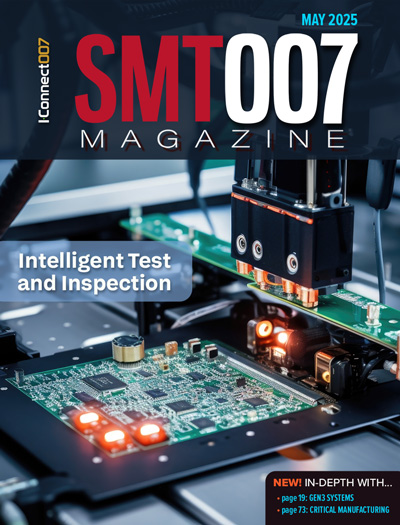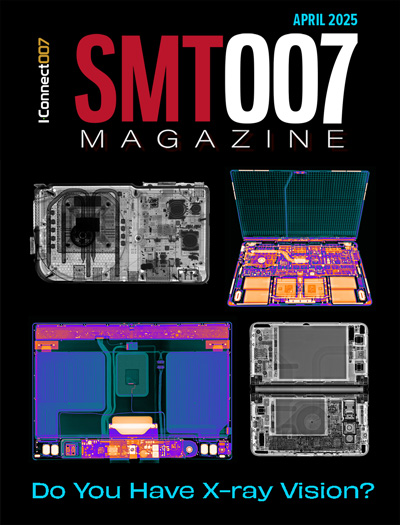-

- News
- Books
Featured Books
- smt007 Magazine
Latest Issues
Current Issue
Intelligent Test and Inspection
Are you ready to explore the cutting-edge advancements shaping the electronics manufacturing industry? The May 2025 issue of SMT007 Magazine is packed with insights, innovations, and expert perspectives that you won’t want to miss.

Do You Have X-ray Vision?
Has X-ray’s time finally come in electronics manufacturing? Join us in this issue of SMT007 Magazine, where we answer this question and others to bring more efficiency to your bottom line.

IPC APEX EXPO 2025: A Preview
It’s that time again. If you’re going to Anaheim for IPC APEX EXPO 2025, we’ll see you there. In the meantime, consider this issue of SMT007 Magazine to be your golden ticket to planning the show.
- Articles
- Columns
Search Console
- Links
- Media kit
||| MENU - smt007 Magazine
Book Excerpt: Cornerstone of Smart Manufacturing—The Convergence of IT and OT
June 10, 2020 | I-Connect007 Editorial TeamEstimated reading time: 2 minutes
Editor’s note: The following is an excerpt from Chapter 2 of the I-Connect007 eBook The Printed Circuit Assembler’s Guide to… Advanced Manufacturing in the Digital Age, written by Oren Manor of Siemens, a Siemens Business.
Chapter 2
The Cornerstone of Smart Manufacturing: The Convergence of IT and OT
The foundation on which data management and the resulting analysis needs to be built is information technology (IT) and operational technology (OT). For Industrial 4.0 to be turned into a reality, an alliance of IT and OT has to happen. Smart manufacturing cannot exist without this cornerstone.
Few business functions are hit harder by digital transformation than IT and OT. Traditionally, these departments have operated in isolation from each other, but for digital transformation in the factory to occur, they have to align. People can resist this kind of fundamental change to the way they do their jobs, but if IT and OT employees can see how their departments benefit from aligning their processes, everyone in the company can move forward. Manufacturers can start embracing Industry 4.0.
A factory is like a living organism with many different parts to it; materials, machines, and the people and the systems that they use to do their jobs. If IT and OT were sharing real-time data to make better business decisions, predict customer trends, and remain ahead of the competition, this would result in improved manufacturing processes, which leads to higher production performance and lower costs (Figure 2.1).
Strong leadership from key stakeholders in the company can ensure that both IT and OT collaborate, providing them with best practices and tools to use can help the company make better products. Enterprises often underestimate the complexity of this convergence. Priorities for what the company stands for and what it wants to achieve has to come from leadership. It is the duty of top-level leadership to adapt and bring about this paradigm shift to create an atmosphere of total collaboration between IT and OT. With senior-level buy-in and commitment to adoption, the two departments can be empowered to pull in the same direction with the right technology and access to the data they need. If this cannot be done, the company will not survive the digital transformation.
IT has often been seen by enterprises as a cost center, and they are not involved in the day-to-day operation or long-term organizational plans. Their role has been limited to a reactionary role responding to company needs as they arise. This is not going to work in today’s market because business needs require a proactive team that can anticipate needs and is ready before the need is imminent.
To download the free eBook The Printed Circuit Assembler's Guide to... Advanced Manufacturing in the Digital Age, written by Oren Manor of Mentor, a Siemens Business, click here.
To view the entire I-Connect007 library of free eBooks, click here.
Suggested Items
Forge Nano Secures $40M to Scale U.S. Battery Manufacturing and Commercial Semiconductor Equipment Businesses
05/02/2025 | Forge NanoForge Nano, Inc., a technology company pioneering domestic battery and semiconductor innovations, announced the successful close of $40 million in new funding.
Commerce Secretary Howard Lutnick Visits TSMC Arizona Fabrication Facility for Third Fab Ground Breaking
05/02/2025 | U.S. Department of CommerceU.S. Secretary of Commerce Howard Lutnick visited the Taiwan Semiconductor Manufacturing Company (TSMC) semiconductor fabrication facility in Phoenix, Arizona where the company broke ground on a third fab facility.
SIA Welcomes Legislation to Strengthen U.S. Semiconductor Manufacturing Credit
05/02/2025 | SIAThe Semiconductor Industry Association (SIA) released the following statement from SIA President and CEO John Neuffer welcoming House introduction of Building Advanced Semiconductors Investment Credit (BASIC) Act.
INEMI Smart Manufacturing Tech Topic Series: Enhancing Yield and Quality with Explainable AI
05/02/2025 | iNEMIIn semiconductor manufacturing, the ability to analyze vast amounts of high-dimensional data is critical for ensuring product quality and optimizing wafer yield.
Alternative Manufacturing Inc. (AMI) Appoints Gregory Picard New Business Development Manager
05/01/2025 | Alternative Manufacturing, Inc.Alternative Manufacturing Inc. (AMI) is pleased to announce the appointment of Mr. Gregory Picard as our new Business Development Manager. Picard brings a wealth of experience in Sales and Business Development, having worked with some of the most prominent names in the industry.


